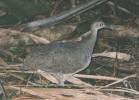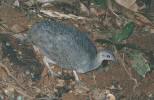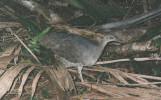Mangoverde :: World Bird Guide :: Tinamous :: Great Tinamou
Great Tinamou Tinamus major
Described by: Gmelin (1789)
Alternate common name(s): None known by website authors
Old scientific name(s): None known by website authors
Photographs




Select thumbnail to view larger image - Place cursor over image for image information
Range
N. Central America to c. South America;
(1) Caribbean lowlands of se. Mexico (ex. se. Puebla, s. Veracruz, n. Oaxaca and n. Chiapas), e. Guatemala w. to Baja Vera Paz, and Honduras.
(2) Se. Mexico (ex. s. Veracruz, Tabasco, s. Campeche and adjacent s. Quintana Roo), Belize, n. Guatemala (Peten s. to Salinas River).
(3) N. Nicaragua, Costa Rica e. to the subtropical zone on Pacific slope of the Guanacaste Cordillera >800m, n. Carara to 1700m in the upper Coto Brus Valley to nc. Panama s. to n. Veraguas and w. Colon. Intergrades with (6) in the Valley of Rio Indio and Caribbean slope of Cocle (El Uracille and Colon).
(4) Sw. Costa Rica (Puntareas, Corcovado National Park and Rio Piries) to e. Pacific slope Panama from w. Chiriqui through e. Veraguas and w. Province of Panama to Canal Zone. Intergrades with (6) in Canal Zone.
(5) Sc. Panama in s. Veraguas and coastal Golfo de Montijo. Ranges to the lower Rio San Lorenzo and w. slope of the Azuero Peninsula, Altos Cacao and the slopes of Cerro Montuosa and Cerro Hoya on the central divide.
(6) Pacific slope of e. Panama from Cerro Azul e. through Darien and along the Caribbean slope from Madden Lake through San Blas to 1400m on Cerro Mali and nw. Colombia (Choco, n. Atioguia s. to middle Atrato). Intergrades with (3) from Cerro Azul, Rio Pequeni and w. San Blas, on the Panama border along the Rio Jurado and e. to the middle Magdalena Valley and s. to Remedios and Antioquia.
(7) Isolated population in sw. Colombia (s. Choco s. along the Pacific coast to the Bando Mountains and Narino) to w. Ecuador to Balzor.
(8) Tropical zone of ne. Colombia from the w. base of the Santa Marta Mountains e. to the w. base of the Perija Mountains and Santander), Venezuela (n. of the Orinoco and s. in w. Bolivar (lower Rio Caura) to area of the Casiquiare Canal and upper Rio Siapa in ex. n. Amazonas).
(9) E. Venezuela (s. of the Orinoco Delta in e. Bolivar to Rio Paragua and the Grand Sabana), Guyana, Surinam, Guiana, ne. Brazil (n. of the lower Amazon w. of the Rio Negro and Manaos and along the Rio Branco).
(10) Se. Colombia (sw. Meta in the Macarena Mountains region and in nw. Meta and Vaupes in Mitu regions), s. in e. Ecuador, e. Peru to ne. Bolivia (n. La Paz, n. Cochabamba and n. Santa Cruz) and ex. w. Brazil s. of the Rio Solimoes e. to Rio Jurua.
(11) Nw. Brazil n. of Rio Solimoes between Rio Negro w. to lower Rio Ioa.
(12) Amazonian Brazil s. of the Amazon from Rio Purus to Rio Guapore e. to n. Mato Grosso (Teles Pires), Para (Cachimbo) to Belem District (Rio Acara).
Videos
No videos are available for this species
Sounds
 Location unknown - Date unknown Source: Naturesongs.com
Location unknown - Date unknown Source: Naturesongs.com
References
Clements, James F. Birds of the World: A Checklist. Vista, CA: Ibis Publishing Company, 2000.
Comments/Errors
Please email with errors/comments on this page or to donate photos.
If there is no family list to the left, you may have arrived at this page from a direct link.
Please select "Mangoverde World Bird Guide" to view the entire bird site.







